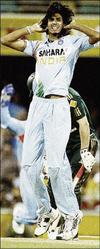
Tony Becca
THE INDIAN cricketers returned home from their tour of Australia a few days ago and the welcome was in stark contrast to that of last year after their disappointing performance in the World Cup.
Last year, India, beaten by Bangladesh, were knocked out in the first round of the World Cup and had to sneak home. This time, after a turbulent tour, after losing an exciting Test series 2-1 to Australia and after winning the tri-nation one-day tournament with a convincing 2-0 win over Australia in the three-match finals, they flew boldly into New Delhi where they were not only met by dignitaries at the airport, where they were not only fêted at the Feroz Shah Kotla Stadium, but where, like the winners of the Under-19 World Cup who were serenaded at Chinnaswamy Stadium in Bangalore a few days earlier with each player rewarded with US$37,000 each, they were also presented with a US$2.5-million bonus for their efforts.
And after the problems in the second Test in Sydney following the row - the name-calling - between Andrew Symonds and Harbhajan Singh, after trailing 2-0 after the second Test in the four-Test contest and looking well beaten, it was a celebration and a reward well deserved.
It showed, beyond a doubt, the resolve and the skill of the Indian players and, most importantly, it demonstrated that as brilliant as they have been, as they are, Australia are mere mortals - and especially so when their tongues are tied.
After losing by 337 runs in Melbourne, after losing by 122 in Sydney - probably because of the umpires and the feeling of despondency, which probably caused them to lose three wickets for no runs in five deliveries in the penultimate over of the Test match, India won the third Test in Perth and in the process snapped Australia's winning streak at 16.
They then drew the fourth and final Test in Adelaide and lost a series 2-1 which, probably but for the umpires, they would have or could have won 2-1.
Australia still the best
To many a fan, and especially so those in the West Indies who are eager to see this Australian team, the challengers to the West Indians of the 1970s and the 1980s as probably the greatest team of all time, cut down to size, the series was so exciting and so close for the simple reason that Australia are ageing and have come or are coming to the end of their reign.
To me, however, that is not so.
Although any team without a pace bowler like Glenn McGrath and a spin bowler like Shane Warne cannot be as strong as when they were around, Australia, with batsmen like Matthew Hayden, Rickey Ponting, Michael Clarke, Michael Hussey, Symonds and Adam Gilchrist, with pace bowlers like Brett Lee, Stuart Clark, Shaun Tait and left-handers Mitchell Johnson and Nathan Bracken, are still strong and still, up to now, the best in the world.
In the Test rankings, Australia are still way in front, they boast three of the top six batsmen and two of the top four bowlers in the rankings and, although they lost the one-day series, they still parade four of the top seven batsmen and two of the top seven bowlers in the rankings and South Africa will have to defeat Bangladesh 3-0 in a series starting on Sunday in order to take over the number-one spot from them.
The truth is that India, ranked at number two in the Test rankings and at number four in the one-day rankings, are good. They are very good in fact and with batsmen like the experienced Sachin Tendulkar, Rahul Dravid, Saurav Ganguly, Virender Sehwag and V.V.S. Laxman, plus ones like Gautam Gambhir, Wasim Jaffer, Mohammad Kaif and Yuvraj Singh, plus youngsters like 23-year-old Vikram Singh, like 22-year-olds Dinesh Karthik, Manoj Tiwary and Robin Uthappa, like 21-year-old Suresh Raina, and one like 20-year-old Robit Sharma, with spin bowlers like the experienced Anil Kumble and Harbhajan, plus 19-year-old legspinner Piyush Chawla, they are sure to get better.
What made India so strong in Australia, however, were their pace bowlers.
After all the investment, it appears that the Dennis Lillee School of Excellence in India is paying off and, as far as planning is concerned, when it comes to development - to the grooming of young batsmen and bowlers, it appears that the West Indies, ranked number eight in both the Test and the one-day rankings for a number of years, have a lot to learn from India.
Quality pace bowlers

Indian bowler Ishant Sharma. - AP
India, the country which once opened the bowling with a medium-pacer from one end and a spin bowler from the other end before going to nothing but spin after a few overs, the country that, on a few occasions, played as many as four spin bowlers in their team, now have a galaxy of quality pace bowlers from which to pick and choose.
Cricket teams around the world beware. In senior man, left-handed swing bowler Zaheer Khan, in 24-year-olds Shanthakumaran Sreesanth and Munaf Patel, in 23-year-old left-handed swing bowler Irfan Pathan, in 22-year-old left-handed swing bowler Rudra Pratap Singh, in 21-year-old Praveen Kumar and in 19-year-old Ishant Sharma, India possess some quality pace bowlers.
On top of all those, they also have waiting in the wings and developing, Pratap Sangwan - a 17-year-old left-handed swing bowler from Delhi, who was their star bowler in the Under-19 World Cup and who, in seven matches, has taken 33 wickets in first-class cricket at an average of 19.22.

